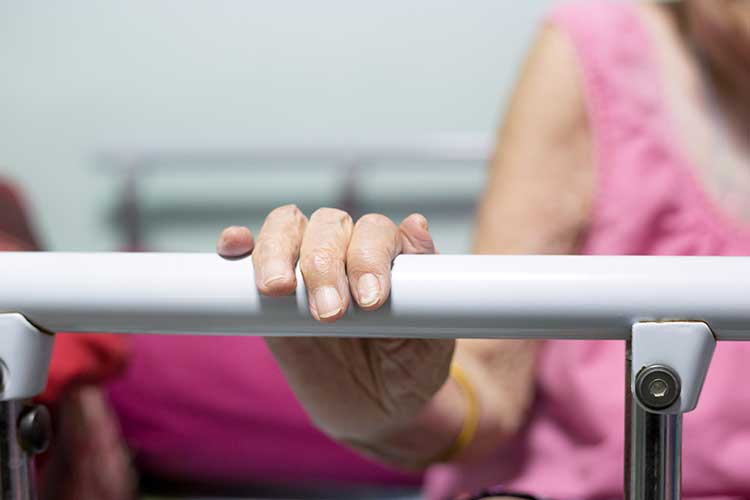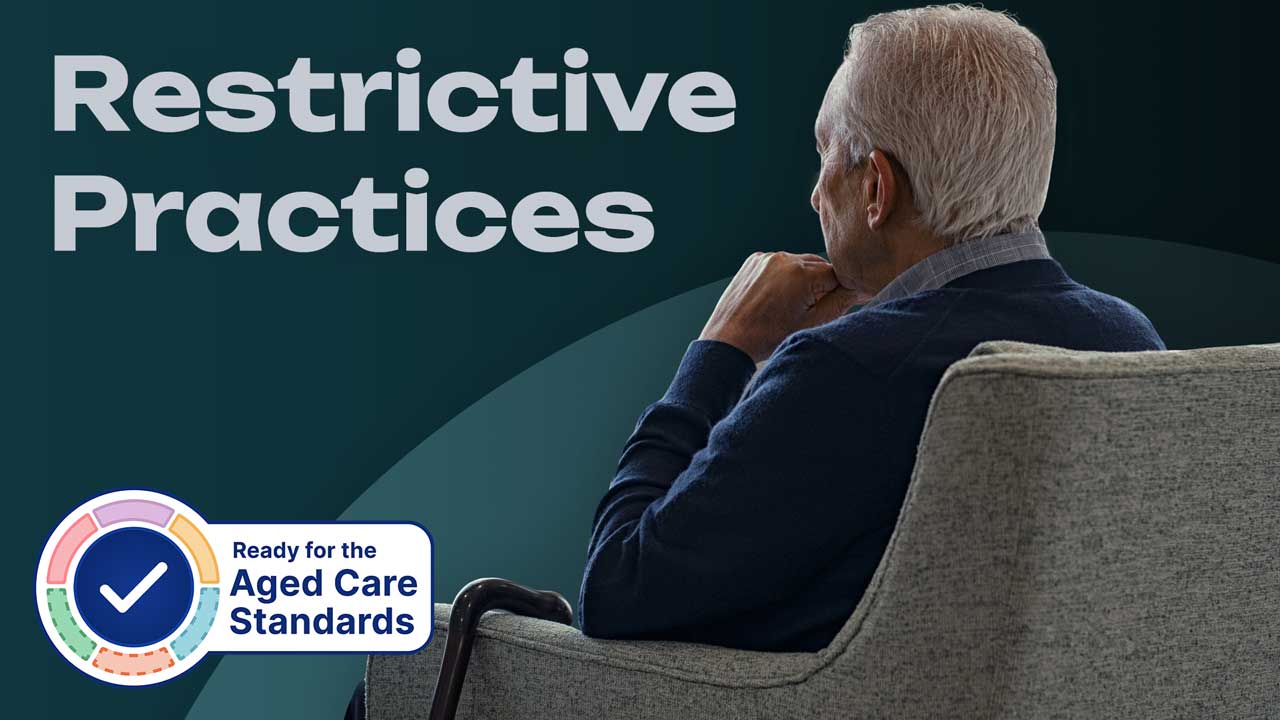This article is intended to be read alongside Alternative Strategies to Restrictive Practices in Aged Care.
Restrictive practices are ethical, legal, and clinical violations of fundamental human rights that may lead to poor care outcomes (VIC DoH 2022).
As much as possible, aged care services should aim to create and maintain a restrictive practice-free environment. This is the recommended standard of care and will prevent older people from suffering unnecessary harm and trauma (VIC DoH 2016).
What is a Restrictive Practice?

The Aged Care Act 1997 defines a restrictive practice as ‘any practice or intervention that has the effect of restricting the rights or freedom of movement of the care recipient’.
There are five types of restrictive practices:
1. Seclusion
Seclusion involves confining a care recipient in a room or physical space by themself (at any hour of the day or night) and preventing them from leaving voluntarily, or implying that they cannot leave voluntarily. Examples include:
- Locking a care recipient in a room
- Imposing a ‘time out’.
(ACQSC 2021)
2. Chemical Restraint
Chemical restraint is the use of medications or chemical substances to influence a person’s behaviour. This does not include medications that have been prescribed by a medical practitioner to treat a mental or physical condition (ACQSC 2021).
3. Mechanical Restraint
Mechanical restraint is the use of devices such as lap belts, bed rails, and restrictive clothing to restrict a person’s movement for the purpose of influencing their behaviour. This does not include devices used for therapeutic or non-behavioural purposes, e.g. a wheelchair (ACQSC 2021).
4. Physical Restraint
Physical restraint is the use of physical force to prevent, restrict or subdue the movement of a person’s body for the purpose of influencing their behaviour. Examples include:
- Physically holding a care recipient in a certain position
- Pinning a care recipient down
- Physically moving a care recipient to prevent them from moving in the direction they wish to go.
(ACQSC 2021)
5. Environmental Restraint
Environmental restraint involves restricting a person’s free access to environments, items or activities. Examples include:
- Removing access to a care recipient’s walking aid
- Requiring a special code to open a door.
(ACQSC 2021)
For more clarification on what is and isn’t considered a restrictive practice, view the following resource from the Aged Care Quality and Safety Commission:
Why are Restrictive Practices Harmful?
Restrictive practices may exacerbate a client’s trauma or inflict physical or emotional harm, posing a profound risk to their safety and wellbeing and even increasing their risk of death. Furthermore, these interventions are not known to alter behaviour long-term (Emanuel et al. 2017; VIC DoH 2022).
Remember that restrictive practices are not therapeutic interventions and should never be treated as such (Melbourne Social Equity Institute 2014).
Just some of the many potential adverse effects of restrictive practices include:
- Feelings of fear, shame, loss of dignity, agitation, or depression
- Reduced cognitive performance
- Physical impacts such as bruises, skin injury, pressure injury, respiratory complications, incontinence, constipation, malnutrition, reduced muscle strength and respiratory complications
- Reduced mobility and increased dependence on others
- Serious injury or death
- Increased falls risk
- Cognitive impairment or confusion.
(RCACQS 2019)

When are Restrictive Practices Permitted?
Restrictive practices must only be used as a last resort to protect a care recipient, yourself, or others from harm. They must be used in the least restrictive form possible, and only after considering the likely impact on the person (ACQSC 2021).
There are strict requirements that must be met in order for a restrictive practice to be used lawfully in a residential aged care setting:
- The restrictive practice must be used as a last resort to prevent harm, after considering the likely impact on the person
- The restrictive practice must be used in the least-restrictive form, for the shortest amount of time possible
- The restrictive practice must be proportionate to the perceived risk of harm
- Alternative strategies to restrictive practices must be attempted first; these must be documented, along with why they have not been successful
- The restrictive practice must be deemed necessary by an approved health practitioner after undertaking an assessment of the resident; this must be documented
- In the case of chemical restraint, the medicine used must have been prescribed by an appropriately qualified health practitioner who has documented the reason for this prescription
- Informed consent must be given from the person or their restrictive practices substitute decision-maker
- The use of restrictive practices must be regularly reviewed and removed as soon as possible
- When the restrictive practice is being used, the person must be regularly monitored for distress, harm, adverse events, changes in wellbeing and ability to perform daily living activities
- Providers must have a Behaviour Support Plan (BSP) in place for all care recipients who:
- Display changed behaviours
- Are being assessed to see if restrictive practices may be needed
- Are experiencing a restrictive practice
- The restrictive practice must be used in accordance with the Charter of Aged Care Rights, the Quality of Care Principles 2014, the Aged Care Quality Standards, relevant state or territory legislation and the care recipient’s BSP
- The Quality of Care Amendment (Restrictive Practices) Principles 2022 sets out a temporary hierarchy of persons or authorised bodies who can give informed consent where restrictive practices are required, and a consumer is unable to provide consent or where restrictive practices substitute decision-maker has not already been appointed. There are five levels of the hierarchy - these are:
- Nominee
- Partner
- Relative or friend who was a carer
- Relative or friend who was not a carer
- Medical treatment authority, who will best support care recipients who cannot consent themselves.
(DoHaAC 2024; ACQSC 2021, 2023)
Restrictive practices should never be used:
- As a therapeutic intervention
- In response to boredom
- In response to illness
- In response to anxiety or distress
- To compensate for staff shortages
- As a substitute for less-restrictive alternatives
- As punishment, threat or discipline
- For the convenience of staff.
(VIC DoH 2016; Melbourne Social Equity Institute 2014; QLD DoH 2016)
Emergency Use of Restrictive Practices
In rare and unexpected emergency situations, providers are permitted to use a restrictive practice.
An emergency scenario is defined as a serious or dangerous situation that is unanticipated or unforeseen and requires immediate action (ACQSC 2021).
In these emergencies, restrictive practices may be used with exemption from certain requirements such as consent. However, the emergency use of restrictive practices may still only be employed under the following conditions:
- The provider must inform the restrictive practices substitute decision-maker of the use of the practice as soon as practicable and record that this notification has been made.
- The following must also be documented in the client’s care and services plan:
- The client’s behaviours that led to the need for a restrictive practice
- Any alternatives to the restrictive practice that were considered or used (if any)
- The reasons why the restrictive practice was necessary
- The care to be provided to the client in relation to their behaviour
- All relevant assessments, information and decisions in relation to the use of the restrictive practice
- Any additional advice or support to be sought.
- Once the emergency is over, the provider must revert to usual restrictive practice policies and procedures
- The provider must seek to employ the least restrictive form of restrictive practice and for the shortest possible time
- The provider must continue to monitor the use of the restrictive practice to decide whether an alternative strategy can be used or the restrictive practice can be ceased.
(ACQSC 2021, 2023)
Restrictive Practices Under the Strengthened Aged Care Quality Standards
Standard 3: Care and Services - Outcome 3.2: Delivery of care and services (Action 3.2.7) under the strengthened Aged Care Quality Standards requires that the use of restrictive practices is minimised as much as possible and that when restrictive practices are used, they are:
- Only used as a last resort
- Used in the least restrictive form and for the shortest length of time possible
- Used with the older person’s informed consent
- Monitored and regularly assessed.
(ACQSC 2024)
Conclusion
Restrictive practices are interventions that should only be used as a last resort.
Remember that these practices are highly distressing for clients and may cause or exacerbate trauma. Your goal should be to minimise and hopefully prevent restrictive practices as much as possible.
Always refer to your state or territory’s legislation, as well as your organisation’s policies and procedures.
Test Your Knowledge
Question 1 of 4
George has Alzheimer's disease and often forgets where his room is located. To assist him, the staff at his aged care facility have placed clear signs on the walls to guide him back to his room safely. Are these signs considered a restrictive practice?
Topics
Further your knowledge
 Free
Free Free
Free Free
Free Free
Free Free
Free Free
FreeReferences
- Aged Care Quality and Safety Commission 2024, Standard 3: Care and Services, Australian Government, viewed 6 May 2024, https://www.health.gov.au/resources/publications/strengthened-aged-care-quality-standards-august-2025?language=en
- Aged Care Quality and Safety Commission 2023, Minimising the Use of Restrictive Practices, Australian Government, viewed 6 May 2024, https://www.agedcarequality.gov.au/older-australians/safety-care/minimising-restrictive-practices
- Aged Care Quality and Safety Commission 2021, Overview of Restrictive Practices, Australian Government, viewed 6 May 2024, https://www.agedcarequality.gov.au/sites/default/files/media/overview-of-restrictive-practices_0.pdf
- Department of Health 2024, Restrictive Practices in Aged Care – A Last Resort, Australian Government, viewed 6 May 2024, https://www.health.gov.au/health-topics/aged-care/providing-aged-care-services/working-in-aged-care/restrictive-practices-in-aged-care-a-last-resort
- Emanuel, LL et al. 2017, Module 13d: Mental Health Care: Seclusion and Restraint: When All Else Fails, The Patient Safety Education Program Canada, viewed 6 May 2024, https://era.library.ualberta.ca/items/1f8210e1-d99b-47a2-ada3-4df6e8e4c4eb/view/c72bc7cd-6ec6-4566-8899-373fe0d44f15/Module%2013d%20Seclusion%20and%20Restraint.pdf
- Melbourne Social Equity Institute 2014, Seclusion and Restraint Project Report, University of Melbourne, viewed 6 May 2024, https://socialequity.unimelb.edu.au/__data/assets/pdf_file/0017/2004722/Seclusion-and-Restraint-report.PDF
- Queensland Health 2016, Physical Restraint, Queensland Government, viewed 6 May 2024, https://www.health.qld.gov.au/__data/assets/pdf_file/0027/465174/cpp-physical-restraint.pdf
- Royal Commission into Aged Care Quality and Safety 2019, Restrictive Practices in Residential Aged Care in Australia, Australian Government, viewed 6 May 2024, https://apo.org.au/node/233756
- Victoria Department of Health 2016, Physical Restraint: Information for Residents, Family and Carers, Victoria State Government, viewed 6 May 2024, https://www2.health.vic.gov.au/about/publications/factsheets/health-literacy-physical-restraint
- Victoria Department of Health 2022, Physical Restraint: Standardised Care Process, Victoria State Government, viewed 6 May 2024, https://www.health.vic.gov.au/residential-aged-care/standardised-care-processes
 New
New 
